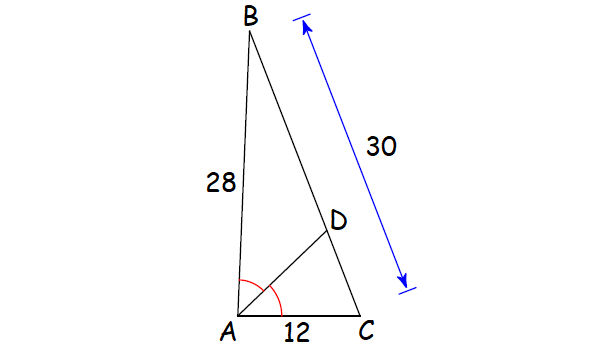The internal (external) bisector of an angle of a triangle divides the opposite side internally (externally) in the ratio of the corresponding sides containing the angle.
Case (i) (Internally) :
Given : In ΔABC, AD is the internal bisector of ∠BAC which meets BC at D.
To prove : BD/DC = AB/AC
Construction : Draw CE ∥ DA to meet BA produced at E.

Proof (Internally) :
Because CE ∥ DA and AC is the transversal, we have
∠DAC = ∠ACE (alternate angles) -----(1)
and
∠BAD = ∠AEC (corresponding angles) -----(2)
Because AD is the angle bisector of ∠A,
∠BAD = ∠DAC -----(3)
From (1), (2) and (3), we have
∠ACE = ∠AEC
Thus in ΔACE, we have
AE = AC
(Sides opposite to equal angles are equal)
Now, in ΔBCE we have, CE ∥ DA.
By Thales Theorem,
BD/DC = BA/AE
Because AE = AC,
BD/DC = AB/AC
Hence the theorem.
Case (i) (Externally) :
Given : In ΔABC, AD is the external bisector of ∠BAC and intersects BC produced at D.
To prove : BD/DC = AB/AC
Construction : Draw CE ∥ DA meeting AB at E.

Proof (Externally) :
Because CE ∥ DA and AC is a transversal, we have
∠ECA = ∠CAD (alternate angles) -----(1)
Also, CE ∥ DA and BP is a transversal, we have
∠CEA = ∠DAP (corresponding angles) -----(2)
But AD is the bisector of ∠CAP,
∠CAD = ∠DAP -----(3)
From (1), (2) and (3), we have
∠CEA = ∠ECA
(Sides opposite to equal angles are equal)
In ΔBDA, we have EC ∥ AD.
By Thales Theorem,
BD/DC = BA/AE
Because AE = AC,
BD/DC = BA/AC
Hence the theorem.




 myCBSEguide
myCBSEguide

Yogita Ingle 5 years, 2 months ago
The internal (external) bisector of an angle of a triangle divides the opposite side internally (externally) in the ratio of the corresponding sides containing the angle.
Case (i) (Internally) :
Given : In ΔABC, AD is the internal bisector of ∠BAC which meets BC at D.
To prove : BD/DC = AB/AC
Construction : Draw CE ∥ DA to meet BA produced at E.
Proof (Internally) :
Because CE ∥ DA and AC is the transversal, we have
∠DAC = ∠ACE (alternate angles) -----(1)
and
∠BAD = ∠AEC (corresponding angles) -----(2)
Because AD is the angle bisector of ∠A,
∠BAD = ∠DAC -----(3)
From (1), (2) and (3), we have
∠ACE = ∠AEC
Thus in ΔACE, we have
AE = AC
(Sides opposite to equal angles are equal)
Now, in ΔBCE we have, CE ∥ DA.
By Thales Theorem,
BD/DC = BA/AE
Because AE = AC,
BD/DC = AB/AC
Hence the theorem.
Case (i) (Externally) :
Given : In ΔABC, AD is the external bisector of ∠BAC and intersects BC produced at D.
To prove : BD/DC = AB/AC
Construction : Draw CE ∥ DA meeting AB at E.
Proof (Externally) :
Because CE ∥ DA and AC is a transversal, we have
∠ECA = ∠CAD (alternate angles) -----(1)
Also, CE ∥ DA and BP is a transversal, we have
∠CEA = ∠DAP (corresponding angles) -----(2)
But AD is the bisector of ∠CAP,
∠CAD = ∠DAP -----(3)
From (1), (2) and (3), we have
∠CEA = ∠ECA
(Sides opposite to equal angles are equal)
In ΔBDA, we have EC ∥ AD.
By Thales Theorem,
BD/DC = BA/AE
Because AE = AC,
BD/DC = BA/AC
Hence the theorem.
0Thank You